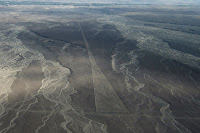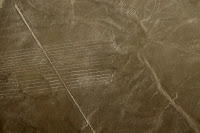
Travel Date 26th March 2010.
Please click on a picture to see the larger version, the small ones do not really show the true picture for these lines.
OK, let's forget about all the little problems of travel such as airport security, pollution-choked cities, unsleepable hostels, a severe lack of vegetables on the menu and extreme cab-driving, here is one of the real reasons I came to Peru.


It didn't disappoint. The Nazca lines are not only one of the great wonders of the world, they are also the one that the world still wonders about. Days like this make the problems insignificant.


Are they landing fields for ancient pre-human astronauts, with guidance beacons and navigational aids, as Erich von Daniken claimed in Chariots of the Gods? I doubt it very much, but my decision to see these lines at some time in my life was made when I read that book in the early '70s when I was in my mid 20s. I didn't believe him then or now – but it was a fascinating subject. And let's be fair – no-one has proved him wrong, because the rest of the scientific world has no better - or worse - theories to offer.


They were re-discovered in modern times when an American water irrigation expert, Paul Kosok, happened to fly over them in a light plane in 1939. Later, he gave a lecture in Lima on the subject and needed an interpreter; that lady was Maria Reiche. She became obsessed with the lines and devoted the rest of her life, until her death in 1998, to studying them.
She measured them and worked out how they were made. Most were created by transferring the oxide-rich reddish rocks on the surface to become the edges outlining the lines and exposing the lighter coloured surface as the filling colour between those edges. She also noticed various astronomical and geographical orientations and attempted to relate some of that to the Pre-Incan Nazca Indian culture – and she still had no idea at the end as to why they were actually created.


Her research was not bettered by others. They ranged from one guy who claimed the Nazca Indians invented the first hot-air balloons (and nearly killed a number of volunteers attempting to prove his theory) to others claiming they were related to ancient Nazcan death-rituals and many in between.

The truth is that nobody really has a clue why some ancient Indians created figures nearly two millennia ago that can only be properly seen from the air or from space.
But they are still absolutely fascinating to see from a light plane. Even if it was the most monumental feat for me on a day when I was suffering from the traveller's curse to keep my lunch down on the flight. But I did – and I even managed to take a few photos at the same time. Since a recent flight crashed killing all on board the Peruvian authorities have decreed that all planes must carry two pilots. Even if they only have one pilot's position...so my four seater Cessna had two pilots and two passengers; it was like flying in a Suzuki hatch. Notice how together the pilots were; myself and my Mexican mate Marcos beside me were very good friends by the end of the flight.
The main difference that decree has made is that there was an instant 50% increase in prices.
The locals have given some of the geoglyphs names. For example, the big picture above is “The Humming-bird”. But I reckon it's more fun if you make up your own – you will be just as correct as they are.


The number of lines and figures is incredible, I have only shown the major ones. But something stands out; these figures were created, re-created, and added to over centuries.
Finally, the flight also showed the dramatic division between the irrigated fertile areas of coastal Peru and the moonscape of the areas beyond irrigation. The bus trip from Lima to Nazca and later from Nazca to Arequipa made this dramatically clear - long distances driving through arid, dusty, hills of dirt and rock with not a hint of green anywhere suddenly changed to lush green pastures. It was very similar to the boundaries between irrigation and desert on the Nile in Egypt.
Cheers, Alan


Thanks for posting the pics, and your notes on their discovery and research. They were an option that I had to drop on my first (and so far only) SA trip, but you've just rekindled my interest in making another one before my vaccinations expire!
ReplyDeleteHow much did the light plane trip cost? And was it just turn up and go, or did you have to pre-book?
G'day Tony
ReplyDeleteI booked via my hostel (the Walk On Inn) but at that time I could have just turned up. The flights now cost US$75, up from $50 since the extra pilot has been added.
PS I'm writing this while the rain pours down at Iguassu Falls, hoping it will stop soon...
Cheers, Alan